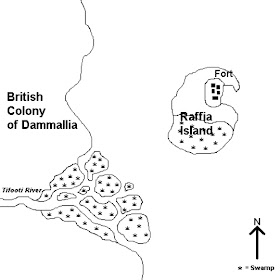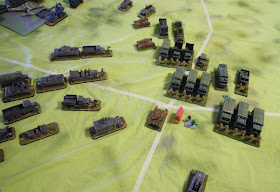The estuary of the Tifooti River is more like a delta, with many different channels through the swamps and sandbanks.
The three dhows slowly but surely negotiated their way through the narrow channels.
Their crews were constantly on the look-out for any Dammallian ships that might be approaching.
As they turned towards the open sea, a tell-tale smudge of smoke was seen on the horizon to the north.
It was a gunboat!
The dhows immediately turned into another channel, hoping that the lookouts on the gunboat had not yet seen the masts and sails of the dhows.
It looked as if their ruse had been successful ...
... and then the gunboat appeared to be slowing and turning!
The dhows could not turn back, so they made a dash for the open sea ...
... only to realise that the gunboat was the Sultan Abdulla, the flagship of the Marzibarian Navy!
Her captain had heard that the Royal Navy was searching for some Marzibarian vessels that were thought to be in the vicinity of the estuary of the Tifooti River, and decided that he should ensure that they were able to proceed on their way unmolested. Therefore, when he saw the dhows emerging from the estuary of the Tifooti River he signalled to them that he would escort them out of Dammallian territorial waters 'for their own safety'.
This was probably a wise move, because just as the Marzibarian gunboat made contact with the dhows, HMS Insolent hove into view from the south.
The Royal Navy ship was too far away from the Marzibarians to intercept them, and the ship's captain – Lieutenant Commander Chamberlain – had to content himself with following the convoy from a distance.
He had a fair idea where the ships were going ... but he would not be certain until they got there.
Note: The arrival of the two gunboats was random. At the beginning of each move I threw a D6 die. If the score was 1, the Marzibarian gunboat arrived from the north, D6 hexes from the shore. If the score was 6, the Royal Navy gunboat arrived from the south, D6 hexes from the shore.
A map of the estuary of the Tifooti River.
The estuary of the Tifooti River looking eastwards.
Having guessed that their presence would not go un-noticed for very long, and fully expecting the Dammallian authorities to react swiftly, the Marzibarians set sail down the Tifooti River towards the sea. They soon reached the river's estuary, and having secured their 'cargo' below, they cleared their decks and prepared for action.The estuary of the Tifooti River looking westwards.
The three dhows slowly but surely negotiated their way through the narrow channels.
Their crews were constantly on the look-out for any Dammallian ships that might be approaching.
As they turned towards the open sea, a tell-tale smudge of smoke was seen on the horizon to the north.
It was a gunboat!
The dhows immediately turned into another channel, hoping that the lookouts on the gunboat had not yet seen the masts and sails of the dhows.
It looked as if their ruse had been successful ...
... and then the gunboat appeared to be slowing and turning!
The dhows could not turn back, so they made a dash for the open sea ...
... only to realise that the gunboat was the Sultan Abdulla, the flagship of the Marzibarian Navy!
Her captain had heard that the Royal Navy was searching for some Marzibarian vessels that were thought to be in the vicinity of the estuary of the Tifooti River, and decided that he should ensure that they were able to proceed on their way unmolested. Therefore, when he saw the dhows emerging from the estuary of the Tifooti River he signalled to them that he would escort them out of Dammallian territorial waters 'for their own safety'.
This was probably a wise move, because just as the Marzibarian gunboat made contact with the dhows, HMS Insolent hove into view from the south.
The Royal Navy ship was too far away from the Marzibarians to intercept them, and the ship's captain – Lieutenant Commander Chamberlain – had to content himself with following the convoy from a distance.
He had a fair idea where the ships were going ... but he would not be certain until they got there.
Note: The arrival of the two gunboats was random. At the beginning of each move I threw a D6 die. If the score was 1, the Marzibarian gunboat arrived from the north, D6 hexes from the shore. If the score was 6, the Royal Navy gunboat arrived from the south, D6 hexes from the shore.


























































